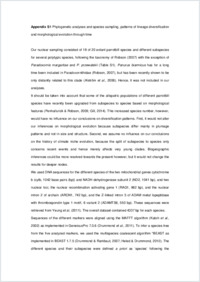Sino-Himalayan mountains act as cradles of diversity and immigration centres in the diversification of parrotbills (Paradoxornithidae)
- Liu, Yang State Key Laboratory of Biocontrol and College of Ecology and Evolution, Sun Yat-sen University, Guangzhou, China
- Hu, Junhua Chengdu Institute of Biology, Chinese Academy of Sciences, Chengdu, China
- Li, Shou-Hsien Department of Life Science, National Taiwan Normal University, Taipei, Taiwan
- Duchen, Pablo Department of Biology, University of Fribourg, Switzerland - Swiss Institute of Bioinformatics, Fribourg, Switzerland
- Wegmann, Daniel Department of Biology, University of Fribourg, Switzerland - Swiss Institute of Bioinformatics, Fribourg, Switzerland
- Schweizer, Manuel Naturhistorisches Museum der Burgergemeinde Bern, Switzerland
-
11.03.2016
Published in:
- Journal of Biogeography. - 2016, vol. 43, no. 8, p. 1488–1501
biogeographical history
climate niche evolution
continental radiation
diversification
ecological niche modelling
ecological opportunity
morphological evolution
parrotbills
Passeriformes
Sino-Himalayan region
English
Aim: Montane regions like the Sino-Himalayas constitute global diversity hotspots. Various mechanisms such as in situ adaptive divergence, speciation following immigration or allopatric diversification in complex landscapes have been proposed to account for the exceptional diversity found in a particular clade in a montane setting. We investigated macroevolutionary patterns to test these different hypotheses in the continental radiation of a Sino-Himalayan bird group, the parrotbills (Paradoxornithidae).Location: Sino-Himalayan region, Indo-Burma.Methods: We used phylogenetic comparative methods based on a multilocus, time-calibrated phylogeny to reconstruct patterns of lineage diversification, biogeographical history, morphological evolution as well as of climate niche history using ecological niche modelling.Results: The radiation of parrotbills started c. 12 Ma, diversifying at an apparent constant rate over time. The biogeographical history appears to be complex, within-region speciation in mountains was restricted to China. Size evolution was concentrated in the early phase of parrotbill radiation, whereas morphological shape evolution did not differ from Brownian motion. We found no indication for niche conservatism, with climate niche evolution occurring throughout the radiation of parrotbills.Conclusions: Parrotbills diversified within a time span of increased regional orogenesis and associated strong climate change. While the south-west and central Chinese mountains were revealed to be a species pump, with in situ allopatric diversification triggered by complex topography and high habitat turnover, the diversity in the Himalayas was chiefly the result of immigration. Evidence for continuous ecological specialization and for the absence of climate niche conservatism could be interpreted as the consequence of ongoing climate- and habitat-induced ecological opportunities. The radiation of parrotbills demonstrates the influence of multiple drivers of diversification in a single group due to the dynamic geological and palaeoclimatic history of the Sino-Himalayan region and illustrates the complex nature of continental radiations.
- Faculty
- Faculté des sciences et de médecine
- Department
- Département de Biologie
- Language
-
- English
- Classification
- Biological sciences
- License
-
License undefined
- Identifiers
-
- RERO DOC 277339
- DOI 10.1111/jbi.12738
- Persistent URL
- https://folia.unifr.ch/unifr/documents/304953
Other files
Statistics
Document views: 144
File downloads:
- pdf: 383
- Supplementary material: 142

